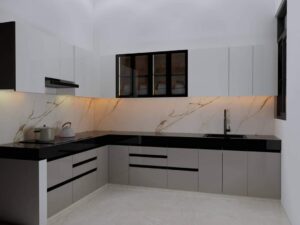The Ultimate Guide to Indian Kitchen Sizes

Indian kitchens are the heart of the home, where not just meals but memories are cooked up daily. They are unique spaces that cater to the diverse and vibrant culinary traditions of the country. Whether you’re designing a new kitchen or renovating an existing one, understanding the various kitchen sizes and layouts prevalent in Indian homes is crucial. This ultimate guide will walk you through everything you need to know about Indian kitchen sizes, helping you make informed decisions for your kitchen space.
The Ultimate Guide to Indian Kitchen Sizes
1. Understanding Indian Kitchen Types
Before diving into the specifics of kitchen sizes, it’s important to understand the types of kitchens commonly found in Indian homes. Kitchens in India can be broadly categorized into three types based on their layout and size:
a. Parallel Kitchen
Also known as a galley kitchen, the parallel kitchen layout features two long countertops facing each other with a central walkway. This design is ideal for narrow spaces and provides ample storage and workspace.
b. L-Shaped Kitchen
The L-shaped kitchen is a popular choice in Indian homes due to its efficient use of corner space. It features two countertops that meet at a right angle, forming an ‘L’ shape. This layout allows for easy movement and is suitable for both small and large spaces.
c. U-Shaped Kitchen
The U-shaped kitchen, also known as a horseshoe kitchen, offers three walls of storage and workspace. This layout is ideal for larger spaces and provides maximum storage and efficient workflow, making it a favorite among avid cooks.
d. Island Kitchen
An island kitchen features a freestanding countertop unit that provides additional workspace and storage. This design is perfect for open-plan homes and offers a social aspect to the cooking area.
e. One-Wall Kitchen
As the name suggests, the one-wall kitchen has all the cabinets and appliances along a single wall. This layout is common in studio apartments and smaller homes where space is at a premium.
2. Determining the Right Kitchen Size
Choosing the right kitchen size depends on various factors such as the size of your household, cooking habits, and available space. Here’s a breakdown of common kitchen sizes in Indian homes and their features:
a. Small Kitchens (60-100 sq. ft.)
Small kitchens are typically found in apartments and smaller homes. Despite their limited space, with smart planning and efficient use of storage, small kitchens can be highly functional.
Features:
- Compact Layout: Often designed as parallel or one-wall kitchens to maximize space.
- Efficient Storage: Utilization of vertical space with wall-mounted cabinets and shelves.
- Essential Appliances: Focus on essential appliances like a stove, refrigerator, and microwave.
- Minimalist Design: Clean and clutter-free design to make the space appear larger.
Design Tips:
- Use Light Colors: Light colors on walls and cabinets can make the space look larger.
- Opt for Multifunctional Furniture: Consider foldable tables or pull-out countertops to save space.
- Install Open Shelves: Open shelves can create an airy feel and provide easy access to frequently used items.
b. Medium-Sized Kitchens (100-200 sq. ft.)
Medium-sized kitchens are the most common in Indian homes. They offer a balance between functionality and space, making them suitable for most households.
Features:
- Versatile Layouts: Can accommodate L-shaped, U-shaped, and parallel layouts.
- Ample Storage: Plenty of cabinets and drawers for storage.
- Multiple Work Zones: Separate areas for prep, cooking, and cleaning.
- Additional Appliances: Space for additional appliances like a dishwasher, oven, or chimney.
Design Tips:
- Create a Work Triangle: Ensure the sink, stove, and refrigerator form a work triangle for efficient workflow.
- Include a Breakfast Counter: If space allows, add a breakfast counter for casual dining.
- Use Under-Cabinet Lighting: Enhance visibility and ambiance with under-cabinet lights.
c. Large Kitchens (200+ sq. ft.)
Large kitchens are usually found in spacious homes and offer ample room for creativity and functionality. They are ideal for families that love to cook and entertain.
Features:
- Spacious Layouts: Can accommodate U-shaped and island kitchens.
- Plenty of Storage: Abundant cabinet space, including walk-in pantries.
- Multiple Appliances: Space for multiple ovens, large refrigerators, and other high-end appliances.
- Dining Area: Room for a full dining table or breakfast nook.
Design Tips:
- Include an Island: An island can provide extra workspace, storage, and a casual dining area.
- Add a Pantry: A walk-in pantry can help keep the kitchen organized and clutter-free.
- Use Statement Lighting: Chandeliers or pendant lights can add a touch of elegance and enhance the kitchen’s aesthetic.
3. Key Measurements and Standards
Understanding the key measurements and standards for kitchen design can help ensure that your kitchen is both functional and comfortable. Here are some important measurements to keep in mind:
a. Countertop Height
The standard countertop height in Indian kitchens is around 34 to 36 inches (86 to 91 cm) from the floor. This height is considered ergonomic for most people, allowing for comfortable food preparation and cooking.
b. Countertop Depth
The standard depth for kitchen countertops is 24 inches (61 cm). This provides enough space for most kitchen tasks and accommodates standard appliances.
c. Cabinet Height
Wall cabinets are typically installed at a height of 18 inches (46 cm) above the countertop. The total height of the cabinets should be around 72 to 84 inches (183 to 213 cm) from the floor, depending on ceiling height and personal preference.
d. Walkway Clearance
Ensure a minimum walkway clearance of 36 inches (91 cm) between countertops or appliances to allow for easy movement and accessibility.
e. Work Triangle
The work triangle refers to the distance between the sink, stove, and refrigerator. For efficient workflow, the sum of the three sides of the triangle should be between 13 to 26 feet (4 to 8 meters).
4. Maximizing Space and Efficiency
No matter the size of your kitchen, maximizing space and efficiency is key to creating a functional and enjoyable cooking environment. Here are some tips to help you get the most out of your kitchen space:
a. Smart Storage Solutions
- Pull-Out Cabinets: Utilize pull-out cabinets and shelves to make the most of deep spaces.
- Corner Cabinets: Install rotating carousels or pull-out trays in corner cabinets to access hard-to-reach items.
- Drawer Dividers: Use dividers to keep utensils, cutlery, and small tools organized.
b. Optimize Vertical Space
- Wall-Mounted Racks: Use wall-mounted racks or magnetic strips for knives, spices, and cooking utensils.
- Tall Cabinets: Install tall cabinets that reach up to the ceiling for additional storage.
- Overhead Pot Racks: Hang pots and pans from overhead racks to free up cabinet space.
c. Efficient Layouts
- Zoning: Divide the kitchen into different zones for prepping, cooking, cleaning, and storage.
- Appliance Placement: Position frequently used appliances within easy reach to streamline the cooking process.
- Open Shelving: Use open shelving for items that are used regularly to make them easily accessible.
d. Lighting and Ventilation
- Task Lighting: Install task lighting under cabinets and over work areas to improve visibility.
- Natural Light: Maximize natural light by using light-colored window treatments and reflective surfaces.
- Ventilation: Ensure proper ventilation with a good quality chimney or exhaust fan to keep the kitchen fresh and odor-free.
5. Customizing Your Kitchen
Personalizing your kitchen to suit your style and needs can make the space more enjoyable and functional. Here are some ideas for customizing your kitchen:
a. Color Scheme
Choose a color scheme that reflects your personality and complements the overall decor of your home. Light colors can make a small kitchen feel larger, while bold colors can add vibrancy to a spacious kitchen.
b. Materials and Finishes
Select materials and finishes that are durable and easy to maintain. Stainless steel, granite, and quartz are popular choices for countertops, while modular cabinets with laminate or acrylic finishes are widely used in Indian kitchens.
c. Backsplash
A stylish backsplash can enhance the look of your kitchen and protect the walls from spills and splashes. Choose from a variety of materials such as ceramic tiles, glass, or stainless steel.
d. Personal Touches
Add personal touches with decorative elements like artwork, plants, or unique hardware. Customized cabinetry, open shelving with curated displays, and bespoke lighting fixtures can add character to your kitchen.
6. Future Trends in Indian Kitchens
Keeping an eye on emerging trends can help you design a kitchen that is modern and up-to-date. Here are some trends to watch for in Indian kitchens:
a. Smart Kitchens
The integration of technology into kitchen design is becoming increasingly popular. Smart appliances, voice-activated assistants, and automated systems can make cooking more convenient and efficient.
b. Sustainable Design
Sustainability is a growing concern, and incorporating eco-friendly materials and energy-efficient appliances into your kitchen can reduce your carbon footprint. Consider using reclaimed wood, recycled materials, and LED lighting.
c. Multi-Functional Spaces
With the rise of open-plan living, kitchens are becoming more than just cooking spaces. Incorporate areas for dining, entertaining, and working to create a multi-functional kitchen.
d. Minimalist Design
A minimalist approach with clean lines, simple color schemes, and clutter-free spaces is gaining popularity. This design philosophy emphasizes functionality and creates a serene cooking environment.
Conclusion
Designing the perfect kitchen requires a balance of aesthetics, functionality, and personal preferences. Understanding the various kitchen sizes and layouts common in Indian homes can help you make informed decisions and create a space that meets your needs. Whether you have a small apartment kitchen or a large, open-plan space, this ultimate guide to Indian kitchen sizes provides the insights and tips you need to design a kitchen that is efficient, stylish, and enjoyable to use.
Remember, a well-designed kitchen is not just about the latest trends or expensive materials. It’s about creating a space that works for you and your family, where you can cook, share meals, and make memories. Happy designing!
Ready to explore a Basic Range of Wood, an Affordable range of galvanized steel and Premium stainless steel kitchen cabinets in Bangalore, kitchen interior & wardrobe solutions for your space? with different combination shutters complete home interiors in steel with Stainless Steel PVD Furniture Contact Karvi Interio today for personalized consultations and expert design services. Visit our website to discover the efficiency and durability of stainless steel wardrobes tailored to your needs. Construction for interior products Gauge, visit our YouTube channel for information videos, Before visiting the showroom some of the steps to follow, Looking for Collaboration with US, About warranty & guarantee, Transform your storage spaces with Karvi Interio’s expertise!

